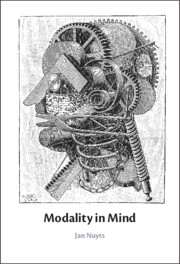Book contents
- Modality in Mind
- Modality in Mind
- Copyright page
- Contents
- Figures
- Tables
- Preface
- 0 Introduction
- 1 The Cognitive-Functional Approach
- 2 Qualifying States of Affairs
- 3 Modality Revisited
- 4 Attitudes
- 5 Beyond the Qualificational Hierarchy
- 6 (Inter)subjectivity, and More
- 7 Back to the Cognitive-Functional Approach
- 8 Conclusion
- References
- Person Index
- Subject Index
2 - Qualifying States of Affairs
Published online by Cambridge University Press: 25 March 2025
- Modality in Mind
- Modality in Mind
- Copyright page
- Contents
- Figures
- Tables
- Preface
- 0 Introduction
- 1 The Cognitive-Functional Approach
- 2 Qualifying States of Affairs
- 3 Modality Revisited
- 4 Attitudes
- 5 Beyond the Qualificational Hierarchy
- 6 (Inter)subjectivity, and More
- 7 Back to the Cognitive-Functional Approach
- 8 Conclusion
- References
- Person Index
- Subject Index
Summary
This chapter defines the most important basic notions and concepts figuring in the analysis of the system of qualifications of states of affairs and their expression in language, as they are used in the book. It defines the semantic categories figuring in the domain of qualifications of states of affairs (often called TAM categories), often in a preliminary fashion as some of them are elaborated or modified in later chapters. It introduces the notion of a hierarchy present in the system of qualificational dimensions, accounting for their semantic scope properties – an analytical concept central in the book. It moreover discusses the notion of a ‘semantic paradigm,’ as a system of expressive devices for a single qualificational category in which each member has slightly different functional characteristics, and it motivates the correlated function-to-form approach adopted in the study for analyzing qualificational categories and their expressions. The chapter moreover does some groundwork for the theoretical issue of the position of the hierarchical system in cognition, arguing that it is conceptual, not linguistic, in nature.
Keywords
- Type
- Chapter
- Information
- Modality in Mind , pp. 36 - 66Publisher: Cambridge University PressPrint publication year: 2025

